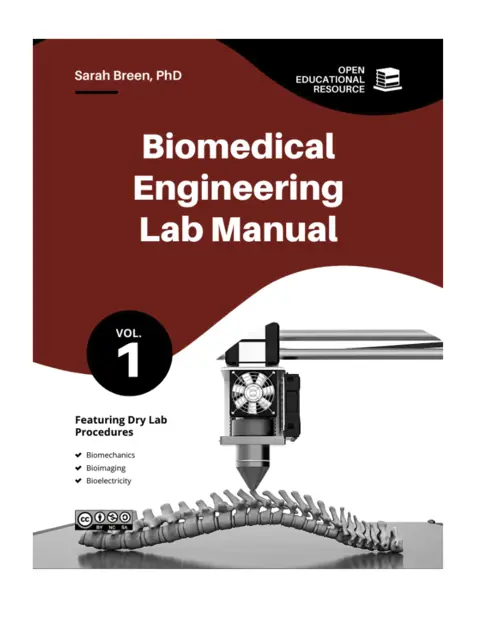
Biomedical Engineering Lab Manual Volume 1
![]()
![]()
![]()
![]()
![]()
Sarah Breen, University of Oklahoma
Copyright Year:
Last Update: 2023
Publisher: SHAREOK
Language: English
Formats Available
Conditions of Use
![]() Attribution-NonCommercial-ShareAlike
Attribution-NonCommercial-ShareAlike
CC BY-NC-SA
Reviews
Reviewed by Hafizur Rahman, Assistant Professor, University of Texas Rio Grande Valley on 5/13/24
The book consists of seven modules/labs. The first three modules/labs are based on biomechanics concepts, human movements, and a class of levers. Module 4 is based on bioimaging and how to perform an ultrasound test. Module 5 is based on... read more
![]()
![]()
![]()
![]()
![]()
Reviewed by Hafizur Rahman, Assistant Professor, University of Texas Rio Grande Valley on 5/13/24
Comprehensiveness
The book consists of seven modules/labs. The first three modules/labs are based on biomechanics concepts, human movements, and a class of levers. Module 4 is based on bioimaging and how to perform an ultrasound test. Module 5 is based on dynamometry and electromyography. Modules 6 and 7 are based on the uniaxial tests of biomaterials and viscoelastic materials.
Content Accuracy
The content is accurate. The book covers how to conduct practical biomedical tests, including those related to biomechanics, bioimaging, and bioelectricity.
Relevance/Longevity
The book was published in 2023, and its contents are up-to-date. The lab activity uses good equipment, such as ultrasound, electromyography, dynamometer, and Newton TestResources machine, to conduct the experimental steps.
Clarity
The complete practical book is written in a simple, easy-to-follow style. For each practical lab, the book provides clear and concise guidelines on how to conduct the tests, ensuring you feel confident and capable of performing them. In some instances, figures are provided, which is beneficial. For each lab activity, there is a pre-lab review that discusses the background and general theory. Sometimes, links to external sources are provided for more in-depth information.
Consistency
The steps to perform an experiment are presented in a consistent manner that is easy to follow. One good thing I like about the book is that each lab has pre-lab and post-lab activities. Pre-lab provides the necessary theoretical background for the test, whereas post-lab activities provide extra higher-order thinking questions.
Modularity
Yes, the activities provided in the book are easy to follow. Headings for different sub-sections and activities are presented in a number sequence. Empty tables and boxes are provided to fill in with the activity outcomes/measurements.
Organization/Structure/Flow
The organization of the book is good. Each lab has three straight sections: i) Pre Lab-Review, ii) Lab Procedures, and iii) Post Lab-Activity.
Each section has multiple sub-sections that make it easy to follow the procedures.
Interface
I did not notice any significant interfaces; the book is easy to follow. The PDF version has a Table of Contents, where clicking any title/topic guides to that section.
Grammatical Errors
I did not notice any grammatical errors. One typo exists in Module 1 Page 1:A in Question 1, where it says "Error", instead of Figure 1-1.
Cultural Relevance
I did not notice any culturally insensitive or offensive language or texts.
CommentsOverall, the book is written in a very good style and systematic way. It consists of seven lab examples of some basic and fundamental concepts that biomedical engineers need to understand. However, for each lab, you need to have a particular set of equipment and devices to conduct the tests. Each module consists of one lab activity, with pre-lab and post-lab activities. Lab steps are written nicely and briefly, making them easy to follow.
Table of Contents
Module 1 Introduction to Functional Human Models
- Pre Lab-Review
- Module 1 Lab Procedure
- Post Lab Activity
Module 2 Functional Human Models
- Pre Lab-Review
- Module 2 Lab Procedure
- Module 2 Post Lab Activity
Module 3 Musculoskeletal Lever Systems
- Pre Lab-Review
- Module 3 Lab Procedure
- Module 3 Post Lab Activity
Module 4 Bioimaging Introduction
- Pre Lab-Review
- Module 4 Lab Procedure
- Module 4 Post Lab Activity
Module 5 Factors Influencing Force Production
- Pre Lab-Review
- Module 5 Lab Procedure
- Module 5 Post Lab Activity
Module 6 Uniaxial Testing & Anisotropy
- Pre Lab-Review
- Module 6 Lab Procedure
- Module 6 Post Lab Activity
Module 7 Uniaxial Testing of Viscoelastic Material
- Pre Lab-Review
- Module 7 Lab Procedure
- Module 7 Post Lab Activity
About the Book
About the Contributors
Author
Dr. Sarah Breen, University of Oklahoma
